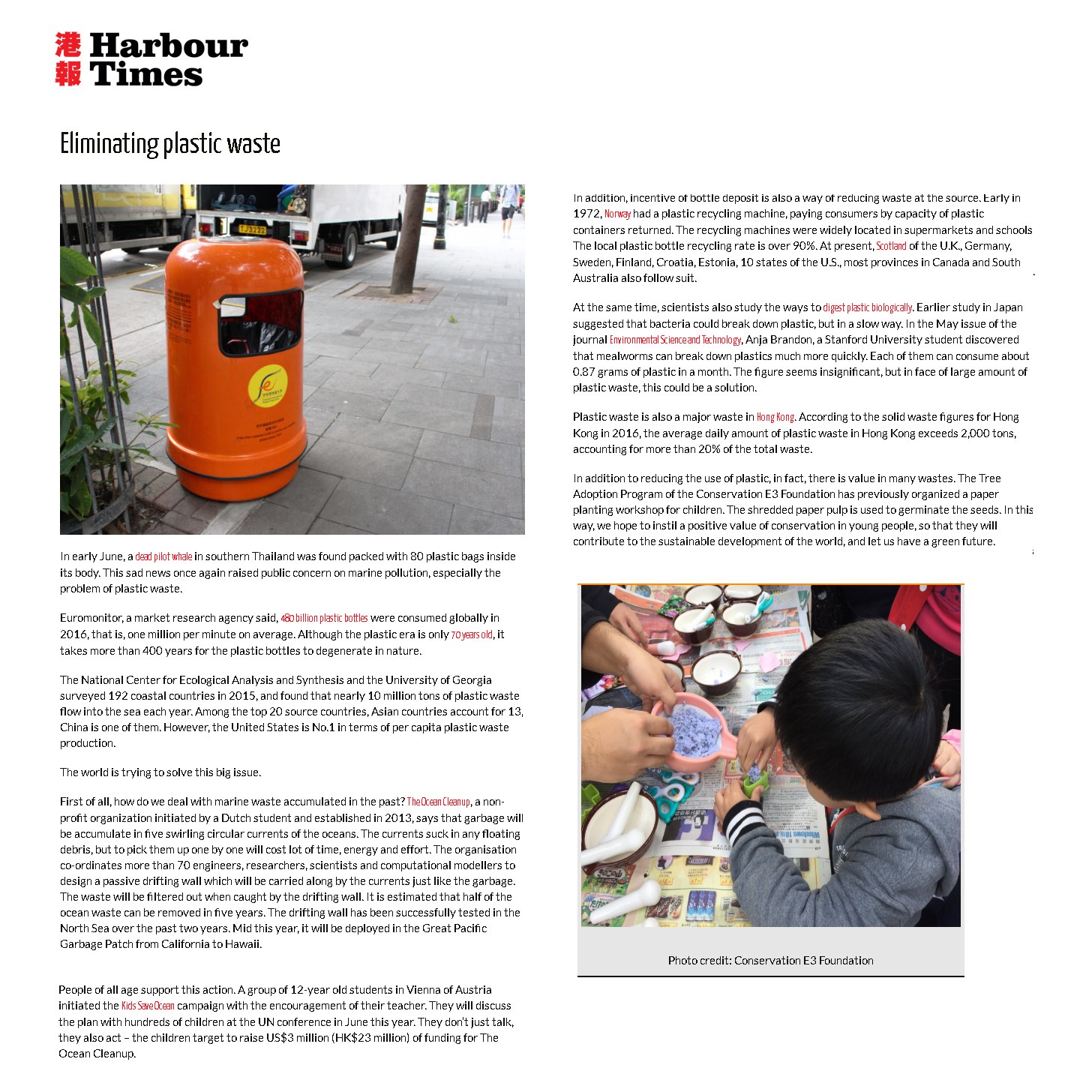網上版請按此

Eliminating plastic waste
In early June, a dead pilot whale in southern Thailand was found packed with 80 plastic bags inside its body. This sad news once again raised public concern on marine pollution, especially the problem of plastic waste.
Euromonitor, a market research agency said, 480 billion plastic bottles were consumed globally in 2016, that is, one million per minute on average. Although the plastic era is only 70 years old, it takes more than 400 years for the plastic bottles to degenerate in nature.
The National Center for Ecological Analysis and Synthesis and the University of Georgia surveyed 192 coastal countries in 2015, and found that nearly 10 million tons of plastic waste flow into the sea each year. Among the top 20 source countries, Asian countries account for 13, China is one of them. However, the United States is No.1 in terms of per capita plastic waste production.
The world is trying to solve this big issue.
First of all, how do we deal with marine waste accumulated in the past? The Ocean Cleanup, a non-profit organization initiated by a Dutch student and established in 2013, says that garbage will be accumulate in five swirling circular currents of the oceans. The currents suck in any floating debris, but to pick them up one by one will cost lot of time, energy and effort. The organisation co-ordinates more than 70 engineers, researchers, scientists and computational modellers to design a passive drifting wall which will be carried along by the currents just like the garbage. The waste will be filtered out when caught by the drifting wall. It is estimated that half of the ocean waste can be removed in five years. The drifting wall has been successfully tested in the North Sea over the past two years. Mid this year, it will be deployed in the Great Pacific Garbage Patch from California to Hawaii.
People of all age support this action. A group of 12-year old students in Vienna of Austria initiated the Kids Save Ocean campaign with the encouragement of their teacher. They will discuss the plan with hundreds of children at the UN conference in June this year. They don’t just talk, they also act – the children target to raise US$3 million (HK$23 million) of funding for The Ocean Cleanup.
In addition, incentive of bottle deposit is also a way of reducing waste at the source. Early in 1972, Norway had a plastic recycling machine, paying consumers by capacity of plastic containers returned. The recycling machines were widely located in supermarkets and schools. The local plastic bottle recycling rate is over 90%. At present, Scotland of the U.K., Germany, Sweden, Finland, Croatia, Estonia, 10 states of the U.S., most provinces in Canada and South Australia also follow suit.
At the same time, scientists also study the ways to digest plastic biologically. Earlier study in Japan suggested that bacteria could break down plastic, but in a slow way. In the May issue of the journal Environmental Science and Technology, Anja Brandon, a Stanford University student discovered that mealworms can break down plastics much more quickly. Each of them can consume about 0.87 grams of plastic in a month. The figure seems insignificant, but in face of large amount of plastic waste, this could be a solution.
Plastic waste is also a major waste in Hong Kong. According to the solid waste figures for Hong Kong in 2016, the average daily amount of plastic waste in Hong Kong exceeds 2,000 tons, accounting for more than 20% of the total waste.
In addition to reducing the use of plastic, in fact, there is value in many wastes. The Tree Adoption Program of the Conservation E3 Foundation has previously organized a paper planting workshop for children. The shredded paper pulp is used to germinate the seeds. In this way, we hope to instil a positive value of conservation in young people, so that they will contribute to the sustainable development of the world, and let us have a green future.
Dr. Winnie Tang
Honorary Professor, Department of Computer Science, The University of Hong Kong
Chairman of the Conservation E3 Foundation